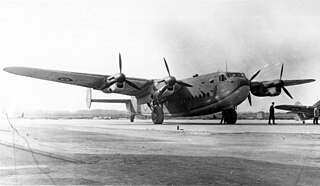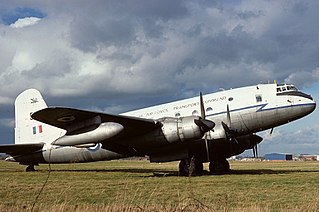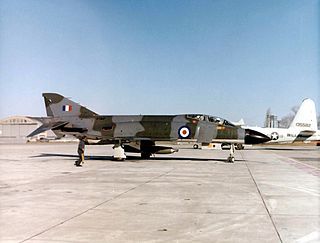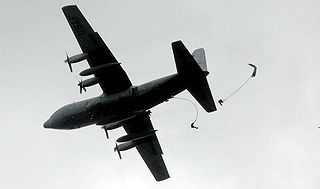 W
WThe Lancaster PA278 disappearance involved Avro Lancaster Mk.I PA278, "F for Freddie", operated by No. 103 Squadron RAF of Bomber Command just after the end of the Second World War.
 W
WThe 1942 Herefordshire TRE Halifax crash occurred on 7 June 1942 during World War II, in the south of Herefordshire a few miles east of the England-Wales border. The Royal Air Force operated Handley Page Halifax II crashed killing eleven people and several important British radar scientists. It is the UK’s worst ever military test flight accident.
 W
WThe 1943 RAF Hudson crash was an aerial accident that killed two people. The aircraft crashed in a forced landing attempt near RAF St Eval, Cornwall, England, following engine failure.
 W
WThe Ålvand Allied bomber crash refers to the shooting down of the Allied Avro Lancaster PB202 by a German night fighter over the small lake Ålvand, in the heathland east of Nørre Vorupør, Thy, Denmark, on the night of 29 August 1944. All of the 7 crew were killed.
 W
WOn April 25, 1944, a Royal Air Force Liberator B Mark VI en route to Britain via Gander, Newfoundland crashed into the Griffintown neighborhood in downtown Montreal, Quebec minutes after taking off from Dorval Airport. The five-member crew and ten civilians on the ground were killed, and a large fire destroyed at least 10 homes.
 W
WThe 1945 Broadway Consolidated Liberator crash occurred on 22 November 1945 when a Royal Air Force Consolidated Liberator C Mk VIII transport crashed shortly after take-off from RAF Merryfield with the loss of all 27 on board.
 W
WThe 1948 Northwood mid-air collision took place on 4 July at 15:03 when a Douglas DC-6 of Scandinavian Airlines System (SAS) and an Avro York C.1 of the Royal Air Force (RAF) collided in mid-air over Northwood in London, UK. All thirty-nine people aboard both aircraft were killed. It was SAS's first fatal aviation accident and was at the time the deadliest civilian aviation accident in the UK. It is still the deadliest mid-air collision in British history.
 W
WThe 1956 London Heathrow Avro Vulcan crash was a military aviation accident that occurred at Heathrow Airport on 1 October 1956 when Avro Vulcan B.1 XA897 crashed while attempting to land in poor weather. The captain and co-pilot ejected safely but the remaining four crew were killed.
 W
WThe Airship NS11 crash was an airship accident which occurred on 15 July 1919. The Royal Air Force (RAF) airship exploded off the east coast of England over the North Sea, killing all nine crew on board.
 W
WOn 6 January 1954 WJ474 a twin-engined Vickers Valetta training aircraft of No. 2 Air Navigation School Royal Air Force crashed near RAF Bovingdon just after takeoff in bad weather.
 W
WThe 1957 Aqaba Valetta accident happened on 17 April 1957 when a twin-engined Vickers Valetta C.1 transport aircraft, serial number VW832, of 84 Squadron, Royal Air Force crashed and was destroyed after departing from Aqaba Airport in Jordan following wing failure due to turbulence. The crash is the deadliest air disaster in the history of Jordan.
 W
WOn 1 February 1945 an Avro York carrying members of the British delegation to the Yalta conference crashed off the Italian island of Lampedusa. During the flight to Yalta, undertaken during night time, the crew became unsure of their position due to a navigation radio malfunction. The aircraft ended up over Lampedusa and circled for approximately one hour as crew members attempted to verify their position. The crew eventually determined the proper course to Malta but by then the aircraft lacked the fuel quantity to cover the distance. During an attempted ditching the Avro crashed into the sea, killing all four crew and 11 passengers. Some sources state there were four survivors.
 W
WThe Dunbeath air crash involved the loss of a Mark 3 Short S.25 Sunderland that crashed in the Scottish Highlands on a headland known as Eagle's Rock near Dunbeath, Caithness, on 25 August 1942. The crash killed 14 of 15 passengers and crew, including Prince George, Duke of Kent, who was on duty as an Air Commodore in the Royal Air Force on a mission to Reykjavik; a message of condolence was proposed in Parliament by the British Prime Minister. A Royal Air Force Board of Inquiry determined that the crash was the result of a navigational error by the crew.
 W
WThe Edmonton air crash occurred on 4 September 1938. A Hawker Audax of No. 1 Elementary and Reserve Flying Training School, Royal Air Force, based at Hatfield, crashed into a residential area in the Edmonton region of London. The aircraft was being flown by a 19-year-old pilot, Sgt Stanley Robert Morris RAFVR. The pilot and 12 people on the ground were killed, including four children.
 W
WThe Elvetham air crash occurred on 5 October 1945 when a Consolidated Liberator GR.VI aircraft, serial number KG867, of 311 Squadron Royal Air Force crashed at Elvetham, east of Hartley Wintney, Hampshire, following a fire in one of its engines and fuel starvation to another.
 W
WThe Exhall mid-air collision happened on Saturday 19 February 1949 over the village of Exhall when a British European Airways Douglas DC-3 / Douglas Dakota collided in clear weather with a Royal Air Force Avro Anson T21.
 W
WThe 1943 Gibraltar Liberator AL523 crash was an aircraft crash that resulted in the death of General Władysław Sikorski, the commander-in-chief of the Polish Army and Prime Minister of the Polish government-in-exile. Sikorski's Liberator II crashed off Gibraltar almost immediately after takeoff on 4 July 1943. An estimated sixteen people died, including many other senior Polish military leaders. The plane's pilot was the only survivor.
 W
WOn 8 February 1956 the Royal Air Force lost six Hawker Hunter jet fighters in a multiple aircraft accident. Eight aircraft from RAF West Raynham had been carrying out a 4x4 dogfight exercise at 45,000 feet (14,000 m). Upon completion of the exercise the eight Hunters diverted to RAF Marham but due to bad weather six of the aircraft were lost including one fatality.
 W
WThe Hawker Hunter Tower Bridge incident occurred on 5 April 1968 when Royal Air Force (RAF) Hawker Hunter pilot Alan Pollock performed unauthorised low flying over several London landmarks and then flew through the span of Tower Bridge on the Thames. His actions were to mark the 50th anniversary of the founding of the RAF and as a demonstration against the Ministry of Defence for not recognising it.
 W
WOn 22 July 1966 Walter "Taffy" Holden, an engineer in command of No. 33 Maintenance Unit RAF with limited experience flying small single-engine trainer aircraft, inadvertently engaged the afterburner of a Mach 2.0-capable English Electric Lightning during ground testing. Unable to disengage the afterburner, Holden ran down the runway narrowly missing a crossing fuel bowser and a de Havilland Comet taking off, before taking off himself. Flying without a helmet, the ejection seat disabled, and the landing gear locked down, Holden aborted a couple of attempted landings. He landed on his third approach, striking the runway with the aircraft's tail as he adopted in his flare the attitude of a taildragger aircraft. The aircraft returned to service, and was subsequently acquired by the Imperial War Museum Duxford.
 W
WThe Imber friendly fire incident took place on 13 April 1942 at Imber in the English county of Wiltshire during the Second World War. One of the Royal Air Force fighter aircraft taking part in a firepower demonstration accidentally opened fire on a crowd of spectators, killing 25 and wounding 71. Pilot error and bad weather were blamed for the incident.
 W
WOn 30 April 1990, a Royal Air Force Avro Shackleton AEW Mk II aircraft, of No. 8 Squadron RAF, based at RAF Lossiemouth, crashed into a hill on the Isle of Harris whilst attempting to land at RAF Benbecula. All ten crew on board died in the crash, which included the wing commander who was in charge of No. 8 Squadron at the time. The Shackleton was the last of the fleet to be involved in a fatal accident, and the type was withdrawn from RAF service in 1991.
 W
WThe Little Baldon air crash occurred on 6 July 1965 when a Handley Page Hastings C1A transport aircraft operated by No. 36 Squadron Royal Air Force, registration TG577, crashed into a field in Little Baldon, near Chiselhampton, Oxfordshire, shortly after taking off from RAF Abingdon. The flight was captained by Flt Lt John Akin. All 41 people aboard, including six crew, perished in the crash, making it the third worst air crash in the United Kingdom at the time.
 W
WThe 1952 Luqa Avro Lancaster crash was a military aviation accident that occurred in Malta on 30 December 1952 when an Avro Lancaster bomber crashed shortly after takeoff from RAF Luqa into a residential area in Luqa. Three of the four crew members on board the aircraft and a civilian on the ground were killed. The crash also caused extensive property damage. The cause of the crash was engine failure.
 W
WOn 15 January 1953, a twin-engined Vickers Valetta transport aircraft of the Royal Air Force (RAF), serial number VX562, collided over the Mediterranean Sea with a four-engined RAF Avro Lancaster maritime patrol aircraft. All 26 people on board both aircraft were killed.
 W
WOn 2 June 1994, a Chinook helicopter of the Royal Air Force (RAF), serial number ZD576, crashed on the Mull of Kintyre, Scotland, in foggy conditions. The crash resulted in the deaths of all twenty-five passengers and four crew on board. Among the passengers were almost all the United Kingdom's senior Northern Ireland intelligence experts. The accident is the RAF's worst peacetime disaster.
 W
WOn 2 September 1995, a Royal Air Force Hawker Siddeley Nimrod aircraft crashed into Lake Ontario during an air display, killing all seven crew members on board. This was the second loss of an RAF Nimrod in four months, following the ditching of a Nimrod R1 in May.
 W
WOn Tuesday 16 May 1995, a Royal Air Force Nimrod R1 aircraft suffered an in-flight engine fire which led to the aircraft having to ditch in the Moray Firth. This was the first of two Nimrods to be lost in 1995; it was followed by the crash of a Nimrod MR2 in Canada in September.
 W
WThe 1974 Norfolk mid-air collision happened on 9 August 1974 at Fordham Fen, Norfolk, England when a Royal Air Force McDonnell-Douglas F-4M Phantom FGR.2 of No. 41 Squadron RAF collided with a Piper PA-25-235 Pawnee crop spraying aircraft. All three aviators were killed: the pilot and navigator of the Phantom and the pilot of the Pawnee. The Phantom pilot was a Royal Air Force Group Captain and station commander of RAF Coningsby. It was the first collision between a civil aircraft and a military fast jet in the United Kingdom low flying military training system.
 W
WOn 9 November 1971, a Royal Air Force Lockheed Hercules C.1 crashed into the sea off the coast of Livorno by Meloria shoal, Italy, killing all 46 passengers and 6 crew. At the time it was described by Italian officials as the worst military air disaster in Italy in peacetime.
 W
WOn 30 January 2005 a Royal Air Force Lockheed C-130K Hercules C3, serial number XV179, callsign Hilton 22, was shot down in Iraq, probably by Sunni insurgents, killing all 10 personnel on board. At the time, the incident was the largest single loss of life suffered by the British military during Operation Telic.
 W
WOn 2 September 2006, a Royal Air Force Hawker Siddeley Nimrod suffered an in-flight fire and subsequently crashed in Kandahar, Afghanistan, killing all fourteen crew members on board. The crash, which occurred during a reconnaissance flight, was the biggest single loss of life suffered by the British military since the Falklands War.
 W
WThe 1942 Ruislip Wellington accident occurred on 18 October 1942 when a Vickers Wellington 1C medium bomber of No. 311 Squadron RAF crashed near South Ruislip station, Middlesex, on approach to RAF Northolt. The crash killed all 15 people aboard the aircraft, and six civilians on the ground including four children.
 W
WThe Sutton Wick air crash occurred on 5 March 1957 when a Blackburn Beverley C Mk 1 heavy transport aircraft, serial number XH117, of 53 Squadron Royal Air Force crashed at Sutton Wick, Drayton, Berkshire, England, following a shut-down of one engine and partial loss of power on another. Shortly after take-off, No. 1 engine was shut down as a precautionary measure then whilst on final approach back to RAF Abingdon, No. 2 engine failed to respond to throttle inputs. The aeroplane struck cables and trees 18 minutes after lifting off.
 W
WThe 1958 Syerston Avro Vulcan crash was a military aviation accident that occurred in England on 20 September 1958 during an air show at RAF Syerston, Nottinghamshire when a prototype Avro Vulcan bomber crashed. All four crew on board and three people on the ground were killed.
 W
WThe 1975 Żabbar Avro Vulcan crash was a military aviation accident that occurred in Malta on 14 October 1975 when an Avro Vulcan B.2 bomber crashed after an aborted landing at RAF Luqa. The aircraft crashed in a residential area in Żabbar, and five crew members and one civilian on the ground were killed. The two pilots managed to eject and survived the accident. The crash caused extensive damage to many buildings in Żabbar.